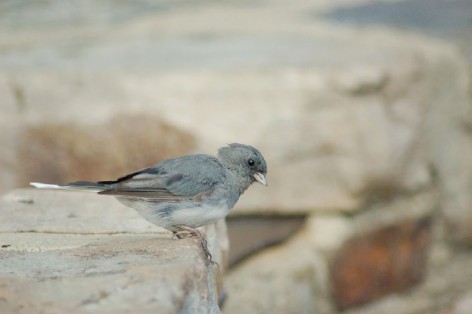David M. Larson

Dark-eyed Junco. Photograph by A. Drauglis (CC BY-SA 2.0).
Many of New England’s favorite bird species are migratory, including wood warblers, shorebirds, waterfowl, and seabirds. These birds largely breed in the north in the summer and migrate to more temperate to tropical climes during the nonbreeding seasons. There are significant physiological advantages to avoiding the harsh winters of the Arctic or Boreal forests. And there are significant reproductive advantages to migrating to the Arctic or Boreal zones for breeding, including abundant food and space for raising young. The evolution of this migratory strategy in so many taxa gives proof to its utility. But with benefits come costs and migration is a perilous practice. Mortality rates are higher in migratory populations than in similar nonmigratory populations, especially during the difficult first year. Increased predation, collision, and disease are all obvious causes of mortality. In addition to these acute effects, other challenges include increased oxidative stress, immunological challenges, and weight fluctuations or even breakdown and reconstitution of muscle and organs.
Bauer, et al. (2016) tested a hypothesis that a long-term detrimental effect of migration might be increased shortening of telomeres in a migratory population of Dark-eyed Juncos as opposed to a nonmigratory population. Telomeres are noncoding DNA segments that cap chromosomes in all multicellular organisms and are thought to protect coding regions of DNA from damage. Telomere lengths shorten with each cell division; when they become short enough, cells senesce (die). While aging clearly leads to telomere shortening, oxidative stress and other metabolic insults may also cause shortening. And that brings us back to migrating juncos.
The authors assessed telomere length in two subspecies of Slate-colored Dark-eyed Juncos: Junco hyemalis hyemalis, which is migratory, and J. h. carolinensis, which is nonmigratory and resident in the southeastern United States. These birds share a wintering ground in Virginia where the authors captured them in Potter traps and mist nets in March. First winter hyemalis had completed one fall migration and then overwintered in the same habitat as the resident carolinensis birds. Blood samples from first winter birds were processed to extract red blood cell DNA, and telomere lengths were assessed using standard molecular assays.
Telomere lengths in carolinensis were significantly longer than in hyemalis, suggesting that one migration leg and the attendant stress was enough to cause loss of telomeres. Clearly, migration is fraught with danger, and the mortality in migratory birds, especially in the first year, is high. Bauer’s work suggests that even for those that survive their first migration, the migratory lifestyle may have detrimental effects on life span. Alternatively, carolinensis may have more active DNA repair mechanisms than hyemalis and so could maintain telomere lengths. If either of these explanations is correct, it is clear that both subspecies are well adapted to their lifestyles. Hyemalis may concentrate its strategy on breeding in optimal locations for increased food availability and success in breeding, whereas carolinensis may focus more on a lower risk strategy.
REFERENCES
- Bauer, C. M., B. J. Heidinger, E. D. Ketterson, and T. J. Greives. 2016. A Migratory Lifestyle is Associated with Shorter Telomeres in a Songbird (Junco hyemalis). The Auk: Ornithological Advances 133: 649-53
David M. Larson, PhD, is the Science and Education Coordinator at Mass Audubon’s Joppa Flats Education Center in Newburyport, the Director of Mass Audubon’s Birder’s Certificate Program and the Certificate Program in Bird Ecology (a course for naturalist guides in Belize), a domestic and international tour leader, Vice President of the Nuttall Ornithological Club, and a member of the editorial staff of Bird Observer.